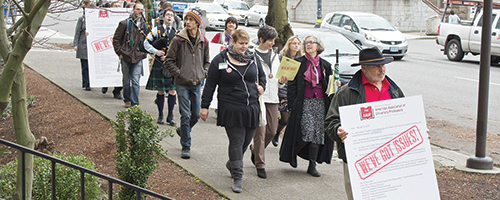Earlier this month, the Life Sciences Collaboration Building [LSCB] Steering Committee announced that it has achieved a series of “significant milestones” regarding the development of the Life Sciences Collaborative Complex.
Higher Ed. board ready to launch life sciences complex
Earlier this month, the Life Sciences Collaboration Building [LSCB] Steering Committee announced that it has achieved a series of “significant milestones” regarding the development of the Life Sciences Collaborative Complex.
The forthcoming 262,000 square-foot scientific research facility will be erected on Oregon Health and Science University’s new Schnitzer Campus on the South Waterfront.
“[The steering committee has] accomplished many of the things that we set out to accomplish on the timeline that we were given by our board, and now we’re ready to launch the project,” said Lindsay Desrochers, vice president of finance and administration at Portland State. Desrochers is also a steering committee member.
One milestone is the completion of a Memorandum of Understanding and a Tenancy in Common agreement between Portland State, on behalf of the Oregon University System and OHSU. The Tenancy in Common agreement is a legal document that delineates how the two institutions will share the property’s ground lease.
As such, it will govern the partnership between the institutions for the next 80 years.
According to Desrochers, the steering committee has also chosen a potential developer, Williams & Dame Development, which will invest in the facility and develop some additional private research space in the building.
Currently, the Tenancy in Common collaborators are negotiating their contract with the development company. They are expected to complete this phase by the end of this year, Desrochers said.
“At this point we have [Williams & Dame’s] response to an RFP [request for proposal], but we are in the process of negotiating the final form of the contract with this group,” said Jay Kenton, OUS vice chancellor for finance and administration. “Without a signed contract, we will not have a project.”
In addition, OUS is currently obtaining the legislative authorization to issue bonds. Due to the passage of Ballot Measures 68 and 69 in May 2010, the Oregon legislature needs to adopt a finding that all previously approved projects are “for the benefit of higher education,” Kenton said.
Measure 68 allows state government to issue bonds to match local school district bonds for school capital costs, while Measure 69 allows the state to issue the lowest-cost bonds to finance projects that would be beneficial to community colleges and public universities.
The funding for the facility will be stitched together from several sources, according to a press release. $50 million of the funding will come from state-funded general obligation (XIG) bonds, $60 million from institutionally-funded general obligation (XIF) bonds, $40 million from a private donation to OHSU,
$10 million from Tri-Met for the construction of a light rail station and $10 to $20 million from private investment.
“We originally sought
$250 million for the project, and it now looks like it will be $170 to $180 million,” Kenton said. “But all of the original components are present, just on a smaller scale.”
According to Desrochers, the construction of the collaborative complex is vitally important for PSU because it will serve as a new base of operation for the university’s two bioscience departments: biology and chemistry. Currently, these subjects are taught out of two campus buildings—Science Buildings 1 and 2—which presently provide less-than-adequate space for student productivity.
“We are way oversubscribed in the [PSU science buildings],” Desrochers said. “We project that by 2012, we’ll be out of space.”
For this reason, the relocation of these departments would be inevitable with or without the collaborative complex, given the growth of these departments, she said.
Oregon’s economic crisis is driving the building project in a somewhat indirect way, according to Denise Wendler, associate vice president for
finance at PSU.
“One of the things that happens when you get into this type of an economy is an inverse reaction with higher ed,” Wendler said. “As the economy goes down, people go back to school, so our enrollments go up, and that actually increases our need for capacity.”
In addition to housing PSU’s bioscience departments, the collaborative complex will house OHSU’s medicine, dentistry, nursing and physician schools, as well as Oregon State University’s pharmacy school. The University of Oregon will also maintain a small presence in the facility with its clinical psychology program, according to Kenton.
The facility will also house retail outlets for private businesses and include privately funded research space for commercial bioscience projects, Desrochers said.
“We will provide a home location for new companies, some of which are expected to come out of the work of PSU faculty because that is how the little bioscience businesses start,” Desrochers said. “We’re leaving the door wide open here for development opportunities that may come from our faculty.”
It is now a matter of getting the business deals done and getting the funds to flow,
she added.
“This is a wonderful example of inter-institutional collaboration in both instructional and research areas,” Kenton said. “It will provide much needed graduates in high-demand fields and will help Oregon diversify its
economy.”?




